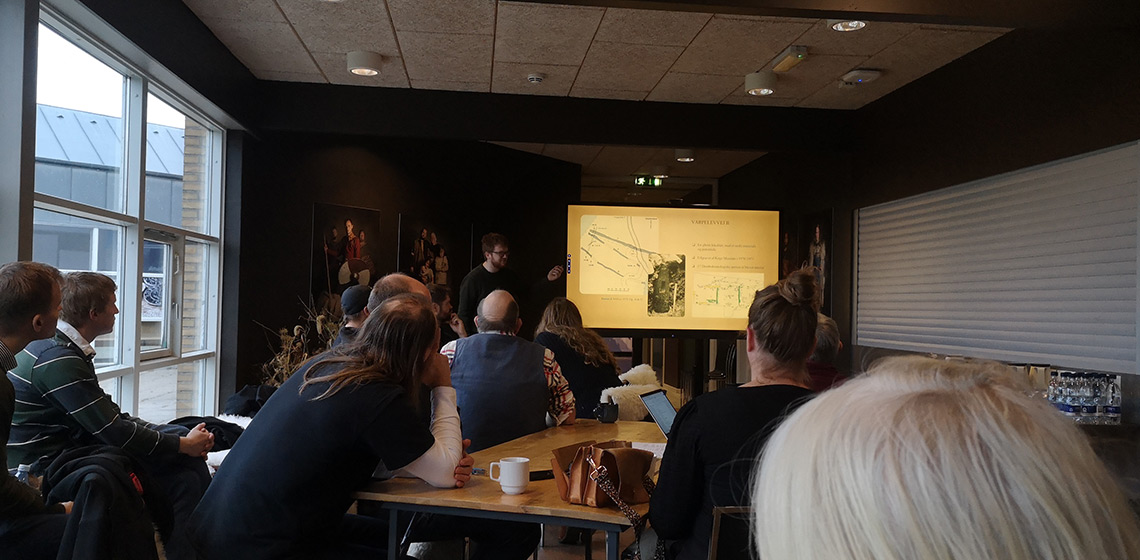The content is published under a Creative Commons Attribution Non-Commercial 4.0 License.
Unreviewed Mixed Matters Article:
Event Review: Experimental Archaeology in Denmark 2024

From the 8th to the 10th of November 2024, the Viking fortress Trelleborg welcomed researchers, students, and craftspeople for three days of celebrating experimental archaeology. This was the fourth annual meeting of “Eksperimentel Arkæologi i Danmark”(EAD) [Experimental Archaeology in Denmark], following the success of meetings at Ribe Vikingecenter, Middelaldercentret, and Bork Vikingehavn. It was the first time the meeting was held on Zealandic soil, and at a UNESCO World Heritage site, no less. Participants from both Denmark and Norway attended. True to the tradition established at the three prior meetings, attendees could arrive on Friday, while Saturday and Sunday were dedicated to discussions on fascinating topics related to experimental archaeology.
Welcoming
The attendees were welcomed by Trelleborg’s museum director, Anne-Christine Larsen, who expressed her delight that the museum at Trelleborg continues to be a hub for experimental archaeology. Trelleborg has a long history of such experimentation, as it still hosts the first-ever reconstructed Viking Age longhouse, completed in 1942. The attendees got the chance to see it during the guided tour. Trelleborg is also home to the main organizer, Gustav Hejlesen Solberg, whose Ph.D. project employs an experimental archaeological approach to Viking Age combat. Solberg gave a talk on some of their experiments on Sunday.
A Breadth of Topics
The talks at this year's meeting covered a remarkably broad range of topics. The day opened with a presentation by Adam Cordes of the National Museum of Denmark on experiments conducted at Lejre: Land of Legends for his Ph.D. project, focusing on beer brewing in prehistoric Denmark. This was followed by Karl Jakob Laberth of Vikingelandsbyen Albertslund, who argued that archaeologists have misinterpreted funnel-shaped glasses as drinking vessels, suggesting instead that they should be understood as glass lamps. His argument was supported by experimental trials, which have also been published in EXARC. Beate Krydsby Kåresen similarly challenged prior archaeological interpretations, this time regarding Norwegian rattles from the Viking Age. She presented compelling arguments that these objects were used to secure loads to sleds, supported by experimental trials.
Different Perspectives on Experimentation
Magnus Hjorth of the National Museum of Denmark presented parts of his MA thesis on preserved timber from Iron Age house constructions that had been deposited in secondary features. Hjorth explored the possibilities and limitations of using reconstructions of Iron Age houses to help archaeologists understand such finds. Mikkel Hansen of De Kulturhistoriske Museer i Holstebro also examined the limits of archaeological processes, presenting results from his BA thesis, for which he tested the soil flotation practices of ten Danish museums. Hansen’s experiments offered lessons on what not to do with flotation. Similarly, Alexander Grove Lauridsen of the University of Copenhagen shared his experiences with a BA thesis experiment on the use of Neolithic arrowheads in Denmark, which did not go as planned, illustrating how failures can also provide valuable insights in experimental archaeology.
Hands-On Approaches
Lars Mørch of Mørchs Smedje shared his experiences as a smith, working with bog iron and transforming it into steel. His expertise with the material and smithing techniques offered deep insights, particularly into the construction of steel files. Kari Marie Helland of Buskerudmuseet discussed her work on historical cooking, focusing on the oldest finds of peas in Norway and how they might have been prepared. Her presentation expanded attendees' knowledge not only of the archaeological evidence, but also of historical gastronomy. Reconstructing, experimenting, and actively engaging with historical materials each offer valuable opportunities for understanding the past. This is one reason why Troels Donnerborg of the National Museum of Denmark incorporates experimental archaeology into his dissemination work. He shared insights into his video series “Test Historien” [Test History], which employs experimental archaeology as a teaching tool.
The Future of EAD
EAD continues to be a vital forum for discussing all aspects of experimental archaeology, including research, public engagement, and dissemination. The event brought together researchers of all levels, craftspeople, journalists, and educators. We look forward to doing it all again next year, in November, this time at Vikingelandsbyen Albertslund. We hope to see you there!
Join EAD
If you want to join EAD’s mailing list, then please contact: jannie.marie.christensen@gmail.com
Find EAD’s facebook group here: https://www.facebook.com/groups/...
Keywords
Country
- Denmark

